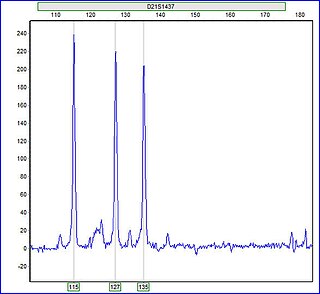
A trisomy is a type of polysomy in which there are three instances of a particular chromosome, instead of the normal two. A trisomy is a type of aneuploidy.

The X chromosome is one of the two sex-determining chromosomes (allosomes) in many organisms, including mammals, and is found in both males and females. It is a part of the XY sex-determination system and XO sex-determination system. The X chromosome was named for its unique properties by early researchers, which resulted in the naming of its counterpart Y chromosome, for the next letter in the alphabet, following its subsequent discovery.
Hypogonadism means diminished functional activity of the gonads—the testes or the ovaries—that may result in diminished production of sex hormones.
Aicardi syndrome is a rare genetic malformation syndrome characterized by the partial or complete absence of a key structure in the brain called the corpus callosum, the presence of retinal abnormalities, and seizures in the form of infantile spasms.
Hypoplasia is underdevelopment or incomplete development of a tissue or organ. Although the term is not always used precisely, it properly refers to an inadequate or below-normal number of cells. Hypoplasia is similar to aplasia, but less severe. It is technically not the opposite of hyperplasia. Hypoplasia is a congenital condition, while hyperplasia generally refers to excessive cell growth later in life.

XXYY syndrome is a sex chromosome anomaly in which males have an extra X and Y chromosome. Human cells usually contain two sex chromosomes, one from the mother and one from the father. Usually, females have two X chromosomes (XX) and males have one X and one Y chromosome (XY). The appearance of at least one Y chromosome with a properly functioning SRY gene makes a male. Therefore, humans with XXYY are genotypically male. Males with XXYY syndrome have 48 chromosomes instead of the typical 46. This is why XXYY syndrome is sometimes written as 48,XXYY syndrome or 48,XXYY. It affects an estimated one in every 18,000–40,000 male births.
The short-stature homeobox gene (SHOX), also known as short-stature-homeobox-containing gene, is a gene located on both the X and Y chromosomes, which is associated with short stature in humans if mutated or present in only one copy (haploinsufficiency).
49,XXXXY syndrome is an extremely rare aneuploidic sex chromosomal abnormality. It occurs in approximately 1 out of 85,000 to 100,000 males. This syndrome is the result of maternal non-disjunction during both meiosis I and II. It was first diagnosed in 1960 and was coined Fraccaro syndrome after the researcher.
Tourettism refers to the presence of Tourette-like symptoms in the absence of Tourette syndrome, as the result of other diseases or conditions, known as "secondary causes".
Mediastinal germ cell tumors are tumors that derive from germ cell rest remnants in the mediastinum. They most commonly occur in the gonad but occasionally elsewhere.

XXY is a 2007 Argentine drama film written and directed by Lucía Puenzo and starring Ricardo Darín, Valeria Bertuccelli, Inés Efron and Martín Piroyansky. The film tells the story of a 15-year-old intersex person, the way her family copes with her condition and the ultimate decision that she must eventually make as she struggles to define her own gender identity within a society that expects certain behaviors from every individual.

The nasal bridge is the upper, bony part of the human nose, which overlies the nasal bones.

Klinefelter syndrome (KS), also known as 47,XXY, is a syndrome where a male has an additional copy of the X chromosome. The primary features are infertility and small, poorly functioning testicles. Often, symptoms are subtle and subjects do not realize they are affected. Sometimes, symptoms are more evident and may include weaker muscles, greater height, poor motor coordination, less body hair, breast growth, and less interest in sex. Often, these symptoms are noticed only at puberty. Intelligence is usually normal, but reading difficulties and problems with speech are more common.
Sex chromosome anomalies belong to a group of genetic conditions that are caused or affected by the loss, damage or addition of one or both sex chromosomes.
Microorchidism is a genetic disorder found in males, characterized by abnormally small testes; it is the opposite of macroorchidism, which is characterized by abnormally large testes.
Harry Fitch Klinefelter, Jr. was an American rheumatologist and endocrinologist. Klinefelter syndrome is named after him.
The Focus Foundation, located in Davidsonville, Maryland, is a research foundation dedicated to identifying and assisting families and children who have X and Y Chromosomal Variations, dyslexia and/or developmental coordination disorder. These conditions can lead to language-based disabilities, motor planning deficits, reading dysfunction, and attention and behavioral disorders. The Focus Foundation believes that, through increased awareness, early identification, and specific and targeted treatment, children with these conditions can reach their full potential.
XXXY syndrome is a genetic condition characterized by a sex chromosome aneuploidy, where individuals have two extra X chromosomes. People in most cases have two sex chromosomes: an X and a Y or two X chromosomes. The presence of one Y chromosome with a functioning SRY gene causes the expression of genes that determine maleness. Because of this, XXXY syndrome only affects biological males, regardless of gender identity. The additional two X chromosomes in males with XXXY syndrome causes them to have 48 chromosomes, instead of the typical 46. XXXY syndrome is therefore often referred to as 48,XXXY. There is a wide variety of symptoms associated with this syndrome, including cognitive and behavioral problems, taurodontism, and infertility. This syndrome is usually inherited via a new mutation in one of the parents’ gametes, as those affected by it are usually infertile. It is estimated that XXXY affects one in every 50,000 male births.

Tetrasomy X, also known as 48,XXXX, is a chromosomal disorder in which a female has four, rather than two, copies of the X chromosome. It is associated with intellectual disability of varying severity, characteristic "coarse" facial features, heart defects, and skeletal anomalies such as increased height, clinodactyly, and radioulnar synostosis. Tetrasomy X is a rare condition, with few medically recognized cases; it is estimated to occur in approximately 1 in 50,000 females.

Pentasomy X, also known as 49,XXXXX, is a chromosomal disorder in which a female has five, rather than two, copies of the X chromosome. Pentasomy X is associated with short stature, intellectual disability, characteristic facial features, heart defects, skeletal anomalies, and pubertal and reproductive abnormalities. The condition is exceptionally rare, with an estimated prevalence between 1 in 85,000 and 1 in 250,000.








